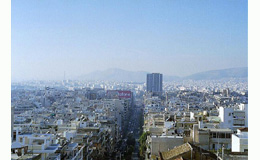COLUMNS
HIGH RISE
Standing on the Acropolis, once upon a time an architect is rumored to have said, looking towards the sea of concrete, which is the trademark of modern Athens:
"This city always struck me as a continuous work-in-project", meaning that the city seems to be nearing the completion of a stage in its development and being close to a leap to the next level, something which never comes, always being postponed.
Very few buildings epitomize the essence of this statement with such intense symbolism more than the incomplete Tower of Piraeus also known as "Piraeus Tower", or "Piraeus Trade Center". The latter was a name tagged to it in a stunning analogy to its role, which was envisioned at the time of construction to be the same for the port of Piraeus with the role of its twin, ill-fated, much larger counterparts that were destroyed on the port of New York in the events of September 11, 2001...
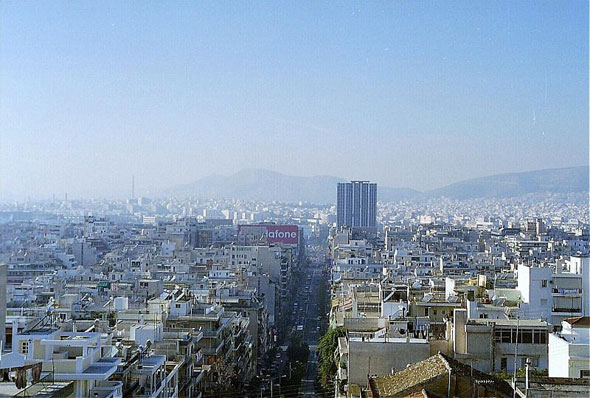
Far view of the Tower
As fate would have it, many decades after groundbreaking, the 25-storey tower (84meters height) still remains a grandiose urban carcass that haunts the skyline of the port of Piraeus. There, in the bustling port, thousands and thousands of commercial ships come and go in a clockwork fashion under the silent presence of the incomplete giant, an image which truly justifies the title of an unfinished "work in progress". An image that clicks in the mind as a silent invitation to (re-)act against the prospect of such a gigantic perpetuated degradation.
Event Chronology
The reasons for what seems to be the perfect urban stagnation tale, which is stunning even for those familiar with the so-called "Greek reality" starts during the years of the military dictatorship (1967-1974). At that time (1968), and under a new law, namely the "Development Law Α.Ν. 395/68 on the Heights of Buildings and Free Construction", construction permits for a few dozens of tall buildings were given (12-28 habitable floors), something that for the lovers of the "Attica Landscape" was and still is "an act of sacrilege" and utter disrespect for the monument of the Acropolis which dominates the historic landscape of the city of Athens.
On the other hand, the construction of the Tower of Piraeus was the result of a political decision that was taken during the same period and after Athens had already built its first (and to many, the only real) skyscraper, the Athens Tower (28 fl, height 103m). The rationale for its construction was related to the desire of the then political regime to provide Piraeus with a landmark icon of economic and urban development and enhance its image as a shipping business and commercial center, as well as to solidify the status of the officers of the then regime as reformers of the Greek political and economic system.
In addition to all the above, the Piraeus Tower may have been perceived as the opposite pole to the Athens Tower, reflecting the relationship between Athens and Piraeus, a fact that may be corroborated by the similar morphology and architectural style of both buildings (International Style).
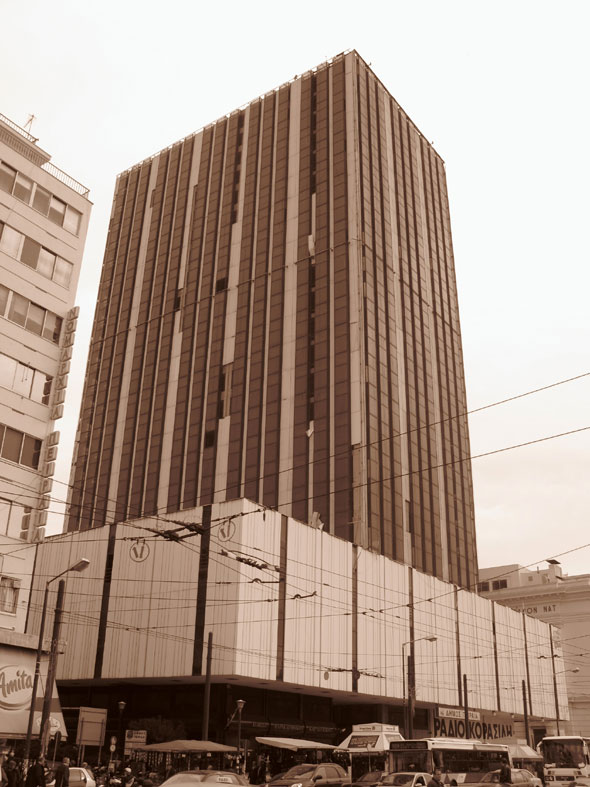
The "Sleeping Giant"
Project Team:
Architects: I. Vikelas, G. Molfesis, A. Loizos
Civil Engineer: A. Oikonomou
In short, the timeline of the most significant events in the life of this building up to the time of this writing are as follows:
-1972 to 1974: Preliminary works and topping out of the frame of the building (Mayor: Mr Skylitsis). During those works, a historic landmark building in the area with a clock on its top is demolished as part of the renovation planning. When the frame is completed, it has 25 floors above the ground level, stands 84m tall and is clearly visible from all parts of the port.
-1983: Cladding of the external surfaces of the building with glass (Mayor: Mr Papaspyrou)
-Late 1980s to present: The three first floors of the building accommodate various uses including a high school, an electronics superstore and public and state authorities. No floors above that level were ever occupied. Various rumors about the static capacity and stability of the building appear in the press and become the object opf concern of mainly the city's society despite the denials coming from the technical world and other official bodies and public authorities.
-1997-1998: Competition for the design and construction with a contractor by the municipality of Peiraius which did was not completed (Mayor: Mr. Logothetis)
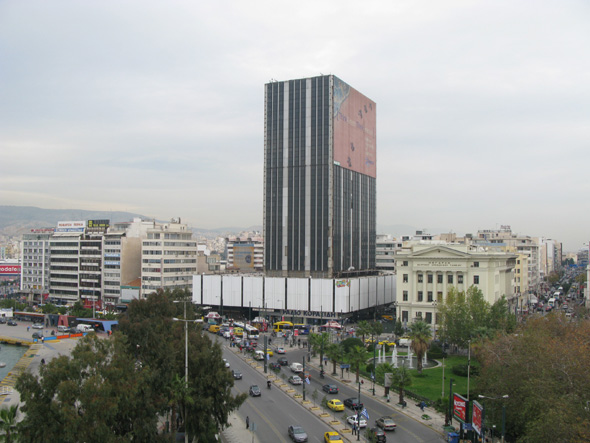
General view of the Tower
- 2001-2: International public 'allocation to the lowest bidder' competition by the municipality of Peiraius (Planning - construction - completion of the Peiraus Tower with the system that includes exchange / operational compromise).
The competition was won by the company 'AVAX', but was never completed. (Mayor Agrapidis)
Today: The structural body of the building is completed. The ground floor stores and the first two floors have been constructed and are in function. The claddings of the external surfaces of the building and the insulation of the second's floor rooftop have been completed. The separate stores that are in use have their own EMP installations.
Since then, the status of the building has not changed despite the good wishes of various parties to assist in its completion. What is surprising is that even the 2004 Summer Olympic games have not been a sufficient cause to mobilize the completion of the building, despite the fact that the port of Piraeus was filled with docked cruise ships, many used as floating hotel facilities at the time.
Note: Some of the basic problems of the building, which were spotted by the municipality of Peiraius and were set at the prescriptions of the past competitions, are the approach to the Tower and the car parking. Initially the building provided very narrow parking area. This fact is aversive for its utilization, since the offered office spaces cannot be served and terrible problems will be generated at this already overloaded area. The adjacency with the terminal train and subway station is a positive element at this direction.
At this point, the direct connection of the possible placement of high rise buildings at the urban habitat with the essence of sufficient public transportation and general access to the buildings, must be underlined. The high rise buildings must not be faced as autonomous building units, rather than as a part of the wider urban habitat. This way high rise buildings can give a solution to the enhancing impasses of the urbanization, rather than making them worse.
Proprietary: According to the proclamation of the competition by the municipality of Peiraius the building is a property of the municipality of Peiraius, except from a ground floor store (334,80 s.m.).
Plot: the plot where the building has been constructed is 3840,30 s.m. at the roads Akti Poseidonos, Dimosthenous, Tsamadou, Ippokratous, Makras Stoas, Anonymos.
Coordinates: 37°56'41"N 23°38'38"E
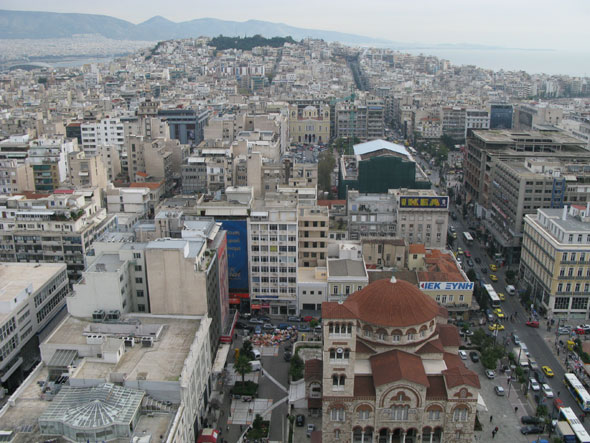
View from the Tower
Technical characteristics of the building
Building plan:
a. Two basements.
b. The narrow volume - ground floor shops, Α' and Β' floor.
c. The high volume - 3rd to 22nd floor
d. The terrace
The surfaces of the above are:
Α. Existing Building
Basement B: 1386 m²
Basement A: 2125 m²
Ground Floor: 2125 m²
Α' and Β' floor: 3147 m² each one
Typical Floor: (3rd - 22nd): 1034 m² (besides the 20th)
20th floor: 648 m²
Terrace: 154 m²
The volume of the building is 91,942 m³
The initial uses of the building were:
1. Basement B: Engine Room
2. Basement A: Garage for the property owners
3. Ground Floor: Stores - Shops
4. Α' and Β' floor: Stores - Shops
5. 3rd floor: Coffee Shop
6. 19th and part of the 20th: Lecture Hall
7. 20th and 21st floor: Restaurant
8. 22nd: EMP facilities
9. Rest of the floors: public services and private offices
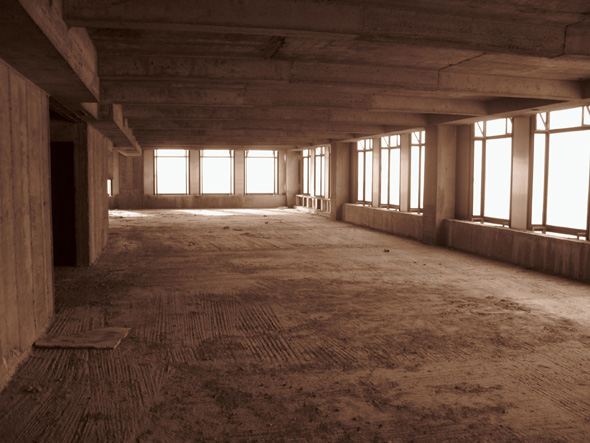
View from the inside of the Tower
Geometrical Characteristics of the building:
1.1.1. Characteristics of the building.
1.1.2. Building Dimensions
2.1. Maximum exterior dimensions (including 58 χ 54 m of sidewalks)
2.2. Exterior dimensions (a' and b' floors), plot area: 3.147 m²
2.3. Typical floor plan: 1.034 m²
2.4. Typical height: 85.02m
2.5. Building height: 84.00m
2.6. Building height without terrace: 80.20 m
1.1.3. Typical Floor characteristics
3.1. Typical Floor dimensions, plot area: 25 χ 40 = 1.034 m²
3.2. Height of typical floor: 3,26 m.
1.1.4. A' and B' floor characteristics
4.1. Α' and Β' floor: 3.147 m²
4.2. A', Β'and C' height: 4.10 m
1.1.5. Basements' characteristics
5.1. Basement B' plot area: 1.386.14 m²
5.2. Basement A' plot area: 2.124.94 m²
5.3. Basement A' Height: 3.00 m
5.4. Basement B' Height: 4.30 m
5.5. Basement C' Height:: 5.50 m
1.1.6. Other Characteristics
6.1. Terrace Dimensions: 11.5 χ 36 m
6.2. Mezzanine Height: 3.50 m., plot area.: 2.125 m²
6.3. Ground Floor height: 3.50 m
In Conclusion...
To many, the prolonged existence of the incomplete tower is yet another proof of the embarrassment from various parties, including the Greek state, the Greek technical construction and architecture community and the public opinion, as to what will be done with this issue. For it is now a common secret that the traditionalists within the Greek architecture and wider general academic community still view tall buildings as negative icons reminiscent of the hatred years of military junta, as well as symbolizing the destruction of the Athenian landscape after the Second World War.
The issue is far beyond the dialectic for the construction (or not) of tall buildings at the Greek Cities and especially in Athens. At the relative column GreekArchitects (http://www.greekarchitects.gr/index.php?maincat=22) there are many writings (at the Greek language) for the specific issue. The paradox is not the acceptance of constructing high rise in Greece, rather than the complete absence of any dialog for this possibility.
In view of the above, it becomes apparent that the main problem here is not the completion of yet another big building whose construction remained on hold for years, as in the case of the new Athens Museum of Modern Art, but it extends well beyond that, and into the acceptance of the re-entry of tall buildings and even skyscrapers into the architectural vocabulary of Piraeus, Athens, and potentially a couple more big cities too.
This prospect of the construction of new tall buildings or even imminently, of world-class skyscrapers (that is, buildings of well above 100m height) still fuels a never-ending controversy and should be seen as one of the most deterring factors in re-opening the discussion about the ages-old 25-floor empty shell still overlooking the port in its seemingly timeless idleness.
Alexios Vandoros, chief editor of GreekArchitects.gr / CTBUH Country Leader for Greece
Grigoris Μaloukos, BSc, MBA / Emporis.com, Editor - Representative for Athens and Greece
Related articles:
- Piraeus Tower – a sleeping giant ( 22 December, 2009 )
- Interesting news for the architectural competition “Piraeus Tower: Changing the Face” ( 18 March, 2010 )
- Piraeus Tower 2010. Press Conference ( 03 March, 2010 )
- Piraeus Tower 2010. Workshop ( 07 March, 2010 )
- Αrchitectural competition in Athens, Greece ( 31 July, 2008 )
- Architectural competition proclamation:“Piraeus Tower 2010 – Changing the Face/Façades Reformation” ( 11 March, 2010 )
- Αrchitectural competition ( 13 March, 2009 )
- Jordi Gavaldá Viñas' Interview at GreekArchitects.gr ( 28 March, 2010 )
- Architectural competition Piraeus Tower 2010 (press release) ( 17 May, 2010 )
- ΕΧΙΒΙΤΙΟΝ Piraeus Tower 2010 ( 20 June, 2010 )
- Ioannis Vikelas : Architectural Pursuits 1958-2010 ( 10 June, 2010 )
- Book Piraeus Tower 2010 ( 03 August, 2010 )
- Piraeus Tower 2010 Results (Web exhibition) ( 26 June, 2010 )
- Piraeus Tower 2010 Competition. Photoreportaz ( 30 June, 2010 )
- Piraeus Tower 2010. Exhibition in Athens ( 06 July, 2010 )
- Piraeus Tower 2010 Competition. Photoreportaz 2 ( 07 July, 2010 )
- Piraeus Tower, an Ideas Tower ( 20 July, 2010 )
- Competition: Piraeus Tower 2010. Interviews with the winners ( 26 July, 2010 )
- Alexandros Tombazis.PIRAEUS TOWER 2010 ( 07 January, 2011 )
- Zisis Kotionis. PIRAEUS TOWER 2010 ( 28 March, 2011 )
- “AGORA” Shopping Center ( 20 November, 2012 )
- Shops & Office building in Maroussi, Athens ( 12 November, 2012 )
- “Atrina” Office Tower in Maroussi, Athens ( 24 December, 2012 )
- “Galleria” Shopping Centre in Glyfada, Athens ( 09 December, 2012 )
- “Atrium” Shopping Centre, Athens ( 19 January, 2013 )
